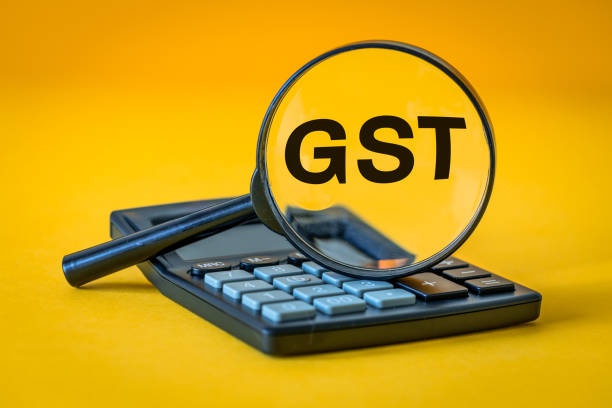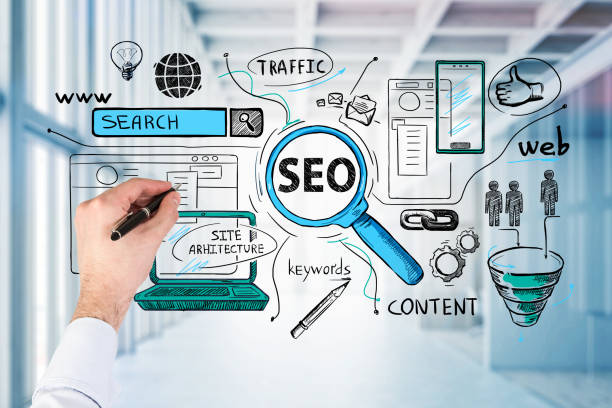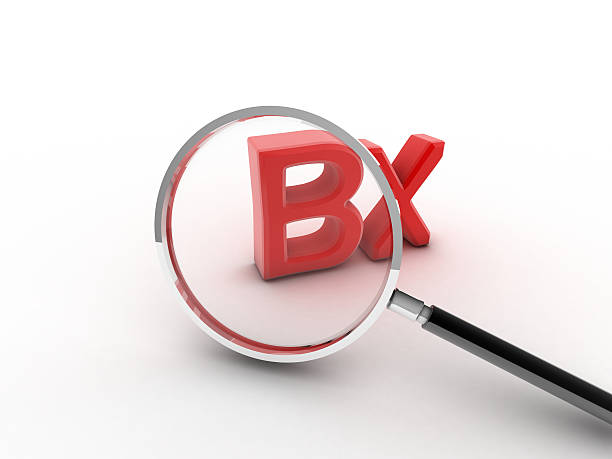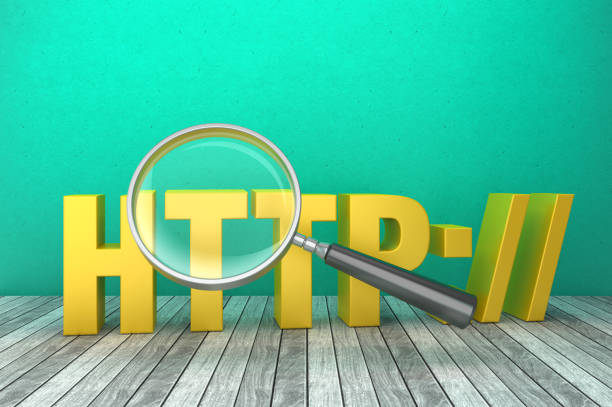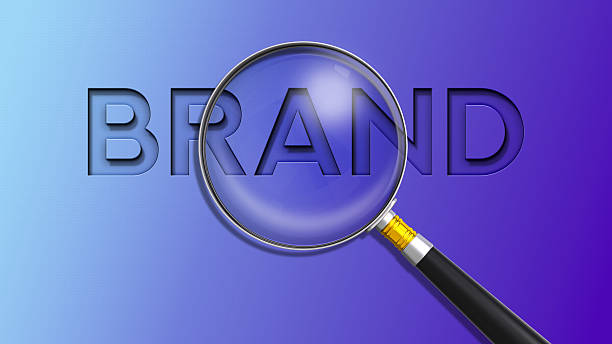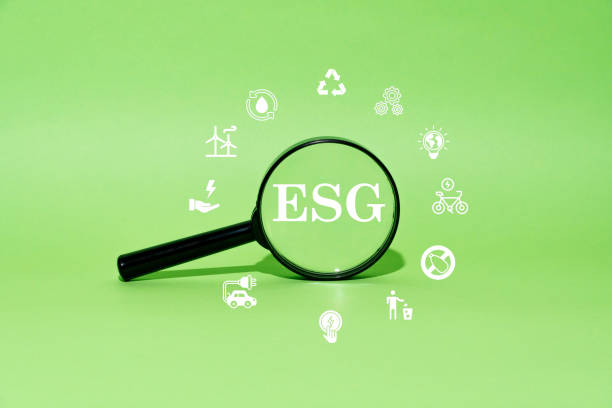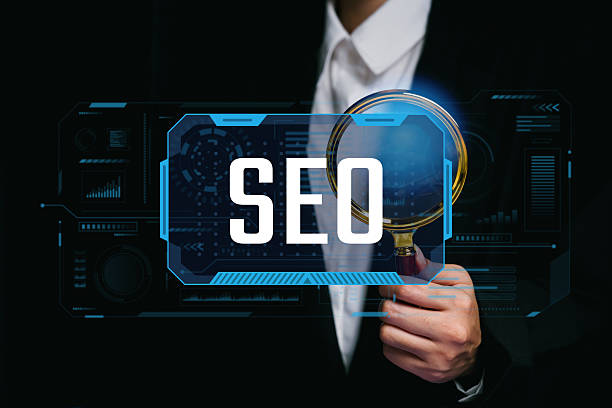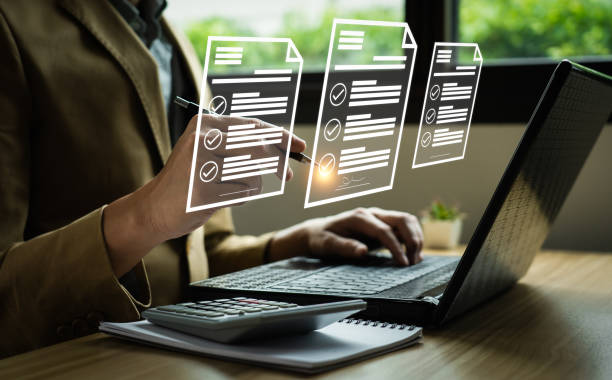What is On-Page SEO and Why is it Important?
#On_Page_SEO is a set of actions you take within your website to improve your site’s ranking in search results on Google and other search engines.
These actions include optimizing content, site structure, HTML code, and other factors related to the inside of the site.
The importance of #On_Page_SEO is that it forms the basis of your site’s ranking.
Without strong on-page SEO, your efforts in #Off_Page_SEO and Content Marketing will not be effective enough.
In fact, on-page SEO helps search engines understand what your site is about and whether it is relevant to the user’s search.
Wikipedia provides more information about SEO.
Good on-page SEO also improves User Experience, which leads to increased user retention time on the site, reduced Bounce Rate, and ultimately increased Conversion Rate.
For example, using relevant keywords, creating quality and useful content, and optimizing site speed all play a role in improving on-page SEO.
On-page SEO helps you get seen.
With principled on-page SEO, you can improve your site’s ranking and gain more organic traffic, and thus boost your business.
On-page SEO includes many elements, including #Content_Optimization, #Keyword_Optimization, #Image_Optimization, and #Site_Structure_Optimization.
By doing proper on-page SEO, you can ensure that your site is properly optimized for search engines and that you can achieve a higher ranking in search results.
How much does it cost you to lose business leads due to an unprofessional website? Solve this problem forever with professional corporate website design by Rasaweb!
✅ Increase the credibility and trust of potential customers
✅ Easier to attract new business leads
⚡ Get a free consultation now!
Keyword Research: Finding Hidden Treasures for SEO
Keyword Research is the process of finding the words and phrases that users use in search engines to find the information, products, or services they need.
This process is the cornerstone of any successful SEO strategy.
Without proper keyword research, your efforts in on-page SEO and Content Creation may be wasted.
There are various tools for keyword research, including Google Keyword Planner, Ahrefs, SEMrush, and Moz Keyword Explorer.
Each of these tools has its own unique features and capabilities, but their goal is to help you find relevant, high-search, and low-competition keywords.
After finding the right keywords, you need to use them strategically in your site’s content.
This includes using keywords in titles, Meta Descriptions, main content text, and Image Alt Tags.
However, you should avoid overusing keywords (Keyword Stuffing), as this can harm your site’s ranking.
The best approach is to use keywords naturally and relevantly in high-quality, valuable content.
On-page SEO helps you understand the needs of users and create appropriate content accordingly.
If on-page SEO is done correctly, it can be effective in optimizing your site’s ranking.
Click here to preview your posts with PRO themes ››
Optimizing Titles and Meta Descriptions: First Encounter with Google
Title Tags and Meta Descriptions are two important elements in the HTML of a web page that are displayed in Google search results.
The title is the main title of the page, which is displayed at the top of the browser and in the search results as a blue link.
The meta description is a summary of the page content that is displayed below the title in the search results.
Optimizing title and meta descriptions is very important for on-page SEO, as these two elements are the first thing users see in the search results and decide whether to click on your link or not.
A good title should be attractive, relevant, and contain the main keyword of the page.
The title length should not exceed 60 characters, otherwise it will be truncated in the search results.
A good meta description should be concise, engaging, and contain relevant keywords.
The meta description length should not exceed 160 characters.
In addition, each page of your site should have a unique title and meta description.
Using duplicate title and meta descriptions can harm your site’s ranking.
On-page SEO can increase your site’s ranking by optimizing this section.
By using the right keywords and providing engaging descriptions, you can encourage users to click on your link and enter your site.
| Element | Description | Best Practices |
|---|---|---|
| Title Tag | The main title of the page that is displayed in the search results. | Engaging, relevant, contains keyword, maximum 60 characters. |
| Meta Description | A summary of the page content that is displayed in the search results. | Concise, engaging, contains keywords, maximum 160 characters. |
Content Optimization: The Kingdom Google Worships
Content is the king of on-page SEO.
Google and other search engines are looking to provide the best and most relevant results to their users, and high-quality, valuable content is the best way to attract their attention.
Content Optimization involves creating engaging, useful, and relevant content with your target keywords.
This includes using keywords in titles, subtitles, main text, and images.
In addition, you should ensure that your content is readable, fluent, and free of grammatical and spelling errors.
Using images, videos, and other visual elements can make your content more engaging and interactive.
Also, you should pay attention to content length.
Longer content usually ranks better in Google, as it provides more opportunity to cover the topic completely and use relevant keywords.
However, you should avoid creating long and boring content.
The best approach is to create high-quality, valuable content that fully answers users’ questions and needs.
On-page SEO can help improve your site’s ranking by creating content.
On-page SEO helps your content get seen better.
Are you annoyed by losing customers due to the outdated appearance or slow speed of your online store? The Rasaweb expert team solves these problems with professional online store website design!
✅ Increase customer trust and brand credibility
✅ Blazing speed and excellent user experience
Get a free consultation with Rasaweb now ⚡
Image Optimization: More Important Than You Think
Images play an important role in the attractiveness and user interaction with your site.
But unoptimized images can slow down your site and harm your on-page SEO.
Image Optimization involves reducing image size, using appropriate formats (such as JPEG for photos and PNG for images with graphics), and adding Alt Text.
Alt Text is a text description for the image that is displayed if the image does not load.
Also, Google uses Alt Text to understand the content of the image.
Therefore, you should use accurate, relevant, and keyword-rich Alt Text.
In addition, you should also optimize image file names.
Instead of using default names (such as IMG_1234.jpg), use descriptive names that contain keywords (such as seo-dakheli.jpg).
By optimizing images, you can increase your site speed, improve user experience, and help your site’s on-page SEO.
On-page SEO helps you optimize your site’s images.
On-page SEO with optimized images can increase your site’s traffic.
Internal Link Structure: Guide for Visitors and Search Engines
Internal Linking Structure refers to how different pages of your site are connected to each other.
Creating a logical and efficient internal link structure is very important for both users and search engines.
Internal Links help users easily navigate your site and find the information they need.
They also help search engines understand your site structure and identify more important pages.
When creating internal links, you should pay attention to a few points.
First, the links should be relevant to the content of the destination page.
Second, you should use descriptive Anchor Text that contains keywords.
Third, you should place the links naturally in the text and avoid overusing them.
By creating a strong internal link structure, you can improve user experience, increase the ranking of your important pages, and help your site’s on-page SEO.
On-page SEO with a proper internal link structure can improve your site’s ranking.
Also, by using internal links, you can help search engines better understand how the pages of your site are related to each other.
Site Speed: A Vital Factor in User Experience and SEO
Website Speed is one of the most important factors in User Experience and on-page SEO.
Users expect site pages to load quickly, and if a site is slow, users are very likely to leave it.
Also, Google considers site speed as one of the ranking factors, and faster sites rank better in search results.
To increase site speed, you can take various measures.
Some of these measures include optimizing images, using a CDN (Content Delivery Network), enabling Gzip compression, and reducing the number of HTTP requests.
Also, you should use a quality and fast Hosting.
By increasing site speed, you can improve user experience, reduce Bounce Rate, and help your site’s on-page SEO.
On-page SEO by increasing site speed can increase your site’s traffic.
| Factor | Description | Solution |
|---|---|---|
| Image Size | Large images slow down site loading speed. | Optimizing images by reducing size and using appropriate formats. |
| Number of HTTP Requests | Each HTTP request increases site loading time. | Reducing the number of requests by merging CSS and JavaScript files. |
| Hosting | Low-quality hosting slows down the site. | Choosing quality and fast hosting. |
Mobile-Friendly: An Inevitable Necessity in Today’s World
With the increasing use of mobile devices to search the Internet, Mobile-Friendly is an inevitable necessity for any website.
Mobile-Friendly means designing a website so that it is displayed well on mobile devices and users can easily interact with it.
Google also considers mobile-friendliness as one of the ranking factors, and mobile-friendly sites rank better in search results.
To make your site mobile-friendly, you should use Responsive Design.
Responsive design means that your site automatically adjusts to the user’s device screen size.
Also, you should use readable fonts, large buttons, and proper spacing between elements so that users can easily interact with your site on mobile devices.
On-page SEO with mobile-friendliness can increase your site’s traffic.
By designing a mobile-friendly site, you can improve user experience, increase Conversion Rate, and help your site’s on-page SEO.
Falling behind in competition with large online stores?
Rasaweb will put your business online and increase your market share by designing a professional online store website!
✅ Increase brand credibility and customer trust
✅ Easy shopping experience leads to more sales
⚡ Act now to receive a free website design consultation!
Using Structured Data: Helping Google Better Understand Content
Structured Data is code that you add to your site’s pages to help Google and other search engines better understand the content of the page.
By using structured data, you can clearly specify important information such as product name, price, rating, and event time for search engines.
Google uses structured data to display Rich Snippets.
Rich snippets are search results that display additional information such as rating, price, and images in addition to the title and meta description.
Rich snippets can increase Click-Through Rate and attract more traffic to your site.
On-page SEO using structured data can help improve your site’s ranking.
On-page SEO with structured information can increase your site’s traffic.
To use structured data, you can use Schema.org.
Schema.org is a set of standard definitions for different types of content that is supported by Google, Microsoft, Yahoo, and Yandex.
By using structured data, you can help Google better understand your site’s content, enable rich search results, and help your site’s on-page SEO.
Monitoring and Measuring Results: Reviewing Performance and Continuous Improvement
After taking on-page SEO measures, you should continuously monitor your results and measure your site’s performance.
This helps you understand which actions have been effective and which actions need improvement.
There are various tools for monitoring and measuring SEO Results, including Google Analytics and Google Search Console.
Google Analytics provides you with detailed information about your site’s traffic, user behavior, and Conversion Rate.
Google Search Console provides you with information about how your site is indexed by Google, the keywords that users use to find your site, and site errors.
Using these tools, you can identify your site’s strengths and weaknesses and adjust your SEO strategy accordingly.
On-page SEO helps you improve your site’s performance.
Remember that on-page SEO is an ongoing process, and you should regularly optimize your site and adapt to changes in Google’s algorithms.
Frequently Asked Questions
| Question | Answer |
|---|---|
| What is On-Page SEO? | On-page SEO includes optimizing elements that are directly in your control and within your website. Its goal is to help search engines better understand the content of the page and improve its ranking. |
| Why is On-Page SEO Important? | On-page SEO gives search engines clear signals about the content of the page, improves user experience, and increases the chances of attracting organic traffic. |
| What are the most important On-Page SEO factors? | Keywords, Title Tag, Meta Description, URL structure, quality content, image optimization, and internal links are among the most important factors. |
| What is the role of the Title Tag in On-Page SEO? | The title tag is one of the most important signals for search engines and users that specifies the main topic of the page. It should include the main keyword and be engaging. |
| How Important is Meta Description? | Meta description does not directly affect ranking, but it can improve click-through rate (CTR) by encouraging users to click. |
| How to Optimize Images for On-Page SEO? | By using a descriptive file name, appropriate Alt Text containing keywords, compression to reduce size, and correct dimensions. |
| What effect do Internal Links have on SEO? | Internal links help search engines discover and index site pages, distribute PageRank throughout the site, and improve user navigation. |
| Is page loading speed one of the On-Page SEO factors? | Yes, page loading speed is a vital factor in On-Page SEO and user experience. Slower pages can lead to higher bounce rates and lower rankings. |
| What are the features of quality content for On-Page SEO? | Quality content should be comprehensive, unique, relevant, reliable, readable, and fully answer users’ needs and questions. |
| How can Keywords be used in Content? | Keywords should be used naturally in the title, subtitles, first paragraph, body text, and Alt Text of images. Avoid Keyword Stuffing. |
and other services of Rasa Web advertising agency in the field of advertising
Intelligent direct marketing: Designed for businesses that want to increase click-through rates through a SEO-oriented content strategy.
Intelligent digital branding: An exclusive service for growing sales based on marketing automation.
Intelligent website development: An exclusive service for growing click-through rates based on the use of real data.
Intelligent SEO: An effective tool for user interaction with the help of attractive user interface design.
Intelligent UI/UX: A quick and efficient solution for analyzing customer behavior with a focus on Google Ads management.
And more than hundreds of other services in the field of internet advertising, advertising consulting and organizational solutions
Internet Advertising | Advertising Strategy | Advertorial Report
Resources
On-page SEO factors you need to know to get the top rank
,What is on-page SEO and why is it important?
,On-page SEO tutorial: Complete step-by-step guide [with checklist]
,What is on-page SEO?+ Comprehensive training and techniques to increase site ranking
? Are you ready to transform your business in the digital world? Rasaweb Afarin Digital Marketing Agency paves the way for you to be seen as much as possible by providing comprehensive services including SEO website design, search engine optimization and content marketing.
📍 Tehran, Mirdamad Street, next to the Central Bank, South Kazeroun Alley, Ramin Alley, No. 6


